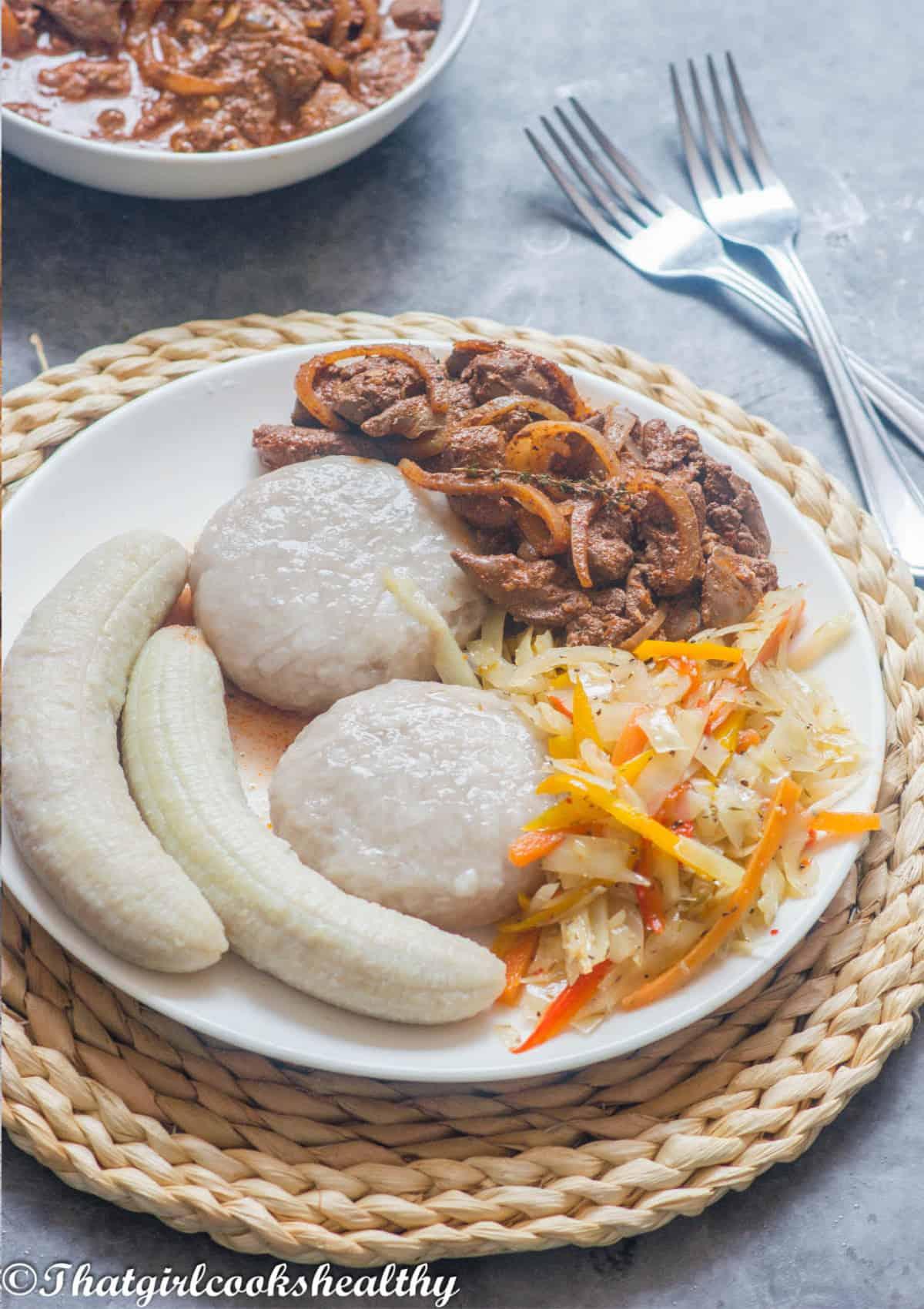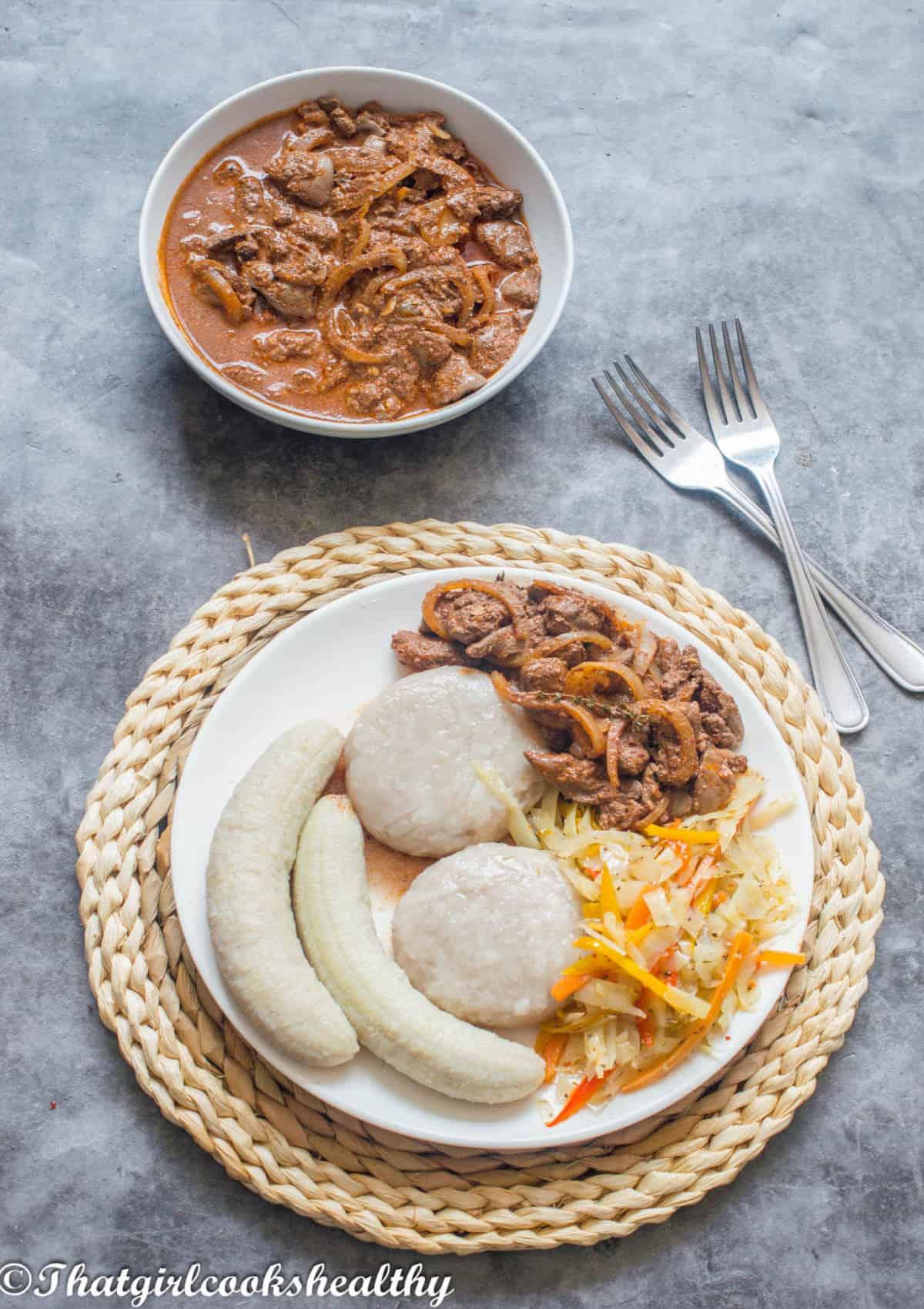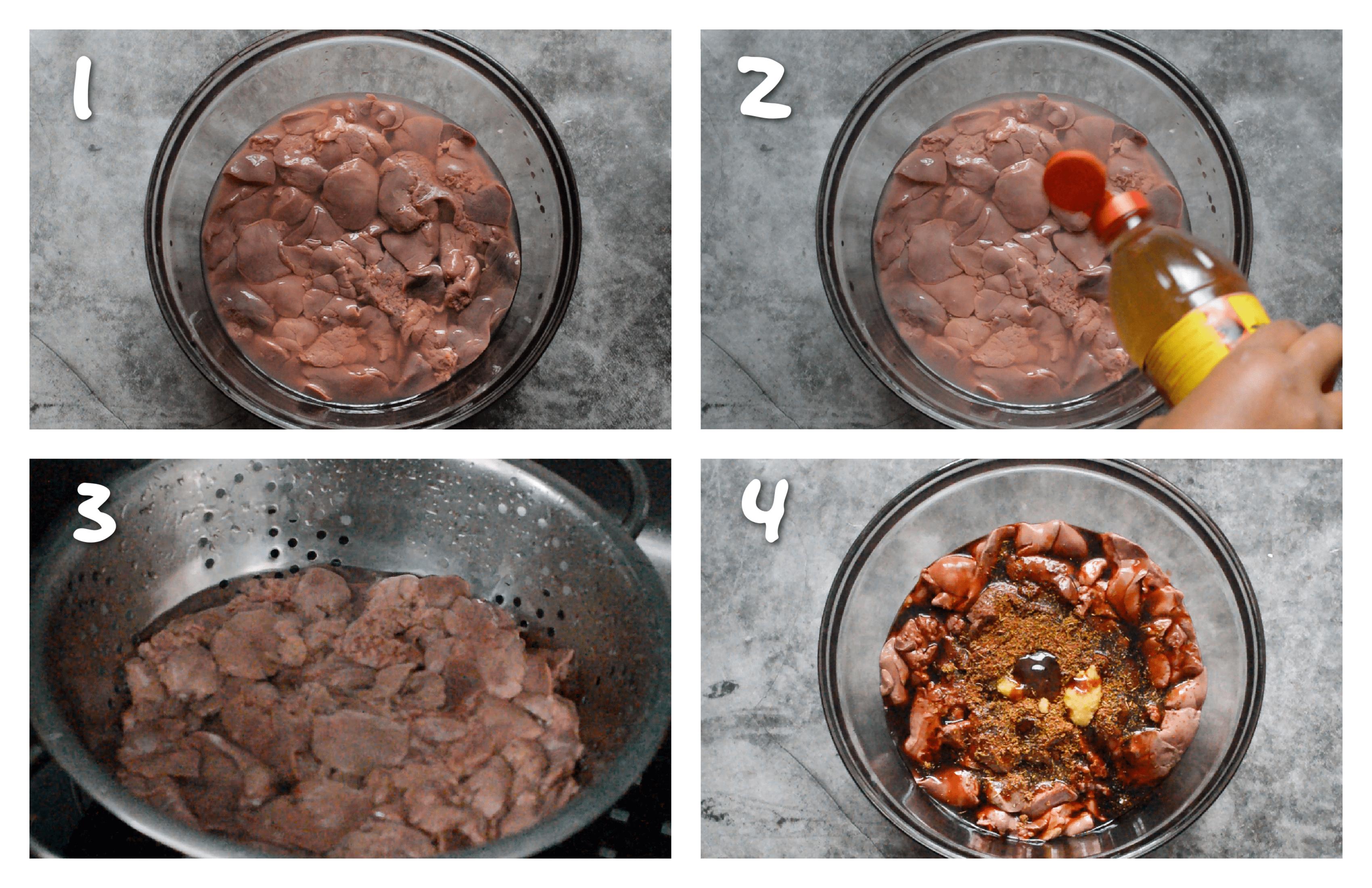Learn how to make this delicious pan seared organic liver that is lightly seasoned then simmered in some tasty gravy. An easy Jamaican inspired recipe that is very filling, served with green banana and cassava dumpling. This dish is definitely a must try for meat eaters.

Hands up if you were forced to eat liver as a youngster?
I know I’m not the only one. Whenever I was anemic the first thing my grandmother and mother would do is to cook up some liver.
I absolutely, used to HATE liver as a child, but I had no choice but to eat it. There simply wasn’t any other option.
As I got older, I learned to appreciate it abit more, but nowadays, I tend to make it on request for my family.
Organ meat/offal is very much subjective, some cultures won’t eat it and perceive it as food for animals i.e their dog. While other cultures are okay with the idea and see nothing wrong with eating it.
I’m not here to debate whether it’s wrong or right, as I always say with my recipes, if you don’t care for a specific recipe, then it’s okay to sit this one out.
I’m going to show you the way my family prepare liver with a few of my own personal tweaks.
From a cultural perspective, Jamaican love their liver (lightly stewed) particularly it is eaten for either breakfast for dinner.
It is a multipurpose food that can be paired with ground provisions i.e yam, breadfruit, dasheen, cassava, plantain etc… and fried or boiled dumpling.
I know in some countries liver is served with either mashed potatoes or rice and the gravy is made from flour, butter and stock.
Reasons to eat liver
Believe it or not, the liver is actually one of the most nutritional dense organ meats that you can eat because it is;
- High in vitamin A and B, which is good for eye health, metabolism and reducing disease which causes inflammation.
- An excellent source of high quality protein.
- Contains folic acid, is also high in iron, chromium, copper, and zinc. These minerals are known to be good for the heart and for increasing hemoglobin level in the blood.
- Eating a single serving of liver can help to meet your daily allowance of vitamins and minerals.
- It is considered a superfood and a budget friendly source of meat to eat (source).
Although the liver is considered a superfood, like other organ meats, however some people avoid or are concerned with eating liver because of it’s role in detoxification.
While the liver does filter toxins and assists with excretion, it does not store them. This is a very common misconception which has created a general misunderstanding of the livers function.
It holds onto the important nutrients only, and this is important to note for anyone who is overly concerned with consumption.
The liver doesn’t store anymore toxins, than any other part of the body, infact toxins that cannot be eliminated accumulate in the fatty tissues and nervous system first, before being stored in the liver.
Liver should be eaten in moderation to form part of a healthy balanced diet and not on a daily basis (the contains dietary cholesterol).
Also, it might be wise to select organ meat such as liver from animals that are organically reared and grassfed (source).
Chicken vs beef liver
In terms of which liver to use for this recipe, I would advise going with either chicken or beef liver.
We tend to rotate between either one of these, with no issues.
What’s more important to note is how the animal was reared, free from any nasties which is why we always purchase organ meat that is organic.
If you do plan on purchasing beef liver, I would recommend calves liver and not from a mature cow.
Calf liver is more milder and tender in taste. On the other hand, liver from a mature cow is older and more dense, gummy with a metallic taste.
Chicken liver is milder in taste, less metallic but can be dry and bitter in taste, if overcooked.
Making the recipe
The key to making a great tasting liver dish is to NOT overcook the liver or it will be rough and rubbery.
I view liver on the same level as shrimp, you get the most out of it by cooking it for a short amount of time.
A lot of people complaint about the bitter/metallic taste, depending on your culture some people will soak their liver first in milk for up to 2 hours.
However, I grew up rinsing my liver in vineger. I also prefer to slice up the liver first before rinsing it so all parts of the liver has been treated.
It’s really up to you in terms of whether you use the milk or vinegar method. The most important thing is to wash the meat before seasoning it.
The steps

- Before slicing the liver, you may need to remove the membrane first (outer coating). Use a small knife to slice through the membrane and peel it off.
- Slice the liver into thin strips (my liver was already sliced by the butcher).
- Place the liver in a bowl with either vinegar and water or almond milk to soak for up to 2 hours.
- Thoroughly rinse off the liver with water, use a colander if you want to aid with the rinsing.
- Once rinsed, blot the liver dry with kitchen towel and place in a medium sized bowl.

- Add the browning, soya sauce, oyster sauce (if using), ginger and all purpose seasoning. Add the pink salt and black pepper if you want to now and thoroughly mix with the liver then set aside.
- Heat olive oil in a medium sized skillet or saucepan on medium heat.
- Add the liver and sear the liver, for a few minutes each side. You don’t need to completely cook it straight away, just brown the meat first. During the searing process the liver should extract it own juices.
- Once browned, place the liver in a bowl and reserve the pan juices and set aside.
- Wipe down the skillet/frying pan and heat up 2 tablespoon more of olive oil on medium heat.
- Sautee the onion and garlic until soft and transculent.
- Stir in the thyme stems, pimento berries, tomato paste and hot sauce.
- Pour the juices from the liver into the skillet/saucepan.

- Pour in the hot water, how much you will need is subjective to the amount of juice that was extracted. You want enough water to make some gravy, start with up to 1 cup and add more when simmering the gravy, if needed.
- Leave the gravy to simmer for 5-7 minutes, stirring occasionally and adding more hot water if required.
- Return the liver to the pan, stir a few times then simmer for up to 8 minutes maximum to avoid the meat becoming too tough.
- Do a taste test and add black pepper and pink salt to taste.
Notes and tips
- The amount of pink salt and black pepper that you will need is subjective to your seasoning, so it is best to add it last.
- Make sure to purchase liver that is “organic” or “grassfed”.
- The amount of water you will need will depend on the amount of liquid that extracts from searing the meat.
- You can either soak the liver in almond milk for up to 2 hours or use the vinegar method.
- Please, please DO NOT overcook your liver, you only need to pan sear and then simmer in the gravy for just under 10 minutes.
- Don’t be tempted to cook the liver for a long period of time i.e.10 minutes plus or your liver will be dense/tough (you have been warned).
- You don’t need to marinate the meat for several hours or overnight. Simply season and move onto the next step.
- For best results, serve immediately, try not to constantly re-heat the liver if possible.

Dumplings for serving
- Boiled Dumpling (plain)
- Coconut Dumpling
- Cassava Dumpling
- Cornmeal Dumpling
Side serving options
- Boiled Green Banana
- Green Banana Mash
- Roast Breadfruit
- Bammy
- Breadfruit Mash
- Callaloo
**Don’t forget to comment below and star rate if you have tried my recipes. Let’s be friends and engage on YouTube, Facebook and Instagram I also like to pin on Pinterest, where you can find more amazing recipes.**



